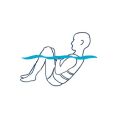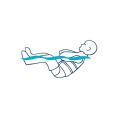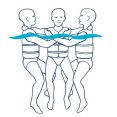Cold Water Boating
Hypothermia
Don't Get Left Out In The Cold
One of the most dangerous aspects of boating, particularly for sportsmen who thrive on cold weather adventure, is the risk of hypothermia. Hypothermia happens when the body loses heat faster than it can produce it. It can occur as a result of prolonged exposure to cold air, or more dramatically, when a person is suddenly immersed in cold water. If a sportsman does fall into very cold water, there is only a limited time before he begins to lose his thinking capability and the use of his limbs. Most experts say that half of all drowning victims do not actually die from water filling their lungs, but instead from the fatal effects of cold water.
Hypothermia and You
Water does not have to be icy to be cold enough to bring on hypothermia, it just has to be colder than you. Cold water is considered to be water under 70 degrees, but imagine, even 80 degree water is still almost 20 degrees colder than your body temperature. Given time, your body’s core temperature will drop as you lose heat to the water.
Hypothermia and Hunters
Waterfowl hunters use boats on some of the coldest days of the year. Not only is the water deathly cold on these days, but the hunter is likely wearing enough layers to make himself heavy and clumsy. If he goes in the water, he’s in serious trouble. Here is where a life jacket or a “float coat” can mean the difference between life and death. Without some flotation device, your chances of survival simply aren’t that good.
Overboard - Now What
If you see yourself about to fall in, if possible, cover your face with your hands. This may sound strange, but quickly becoming immersed in icy water can cause “Torso Reflex,” or a sudden involuntary intake of breath. Covering your mouth is an attempt to avoid gulping water into your lungs when this happens.
Try to hold onto something that floats
If you are wearing a life preserver, great. If there are more floating in the water, grab those too to use as floats. Even decoys can be used, one under each arm, to keep you floating. Try to hold onto your boat, or even right the boat and climb inside (some boats are inherently buoyant and float even when filled with water). The idea is to get as much of your body out of the water as possible, so there is less area that can lose heat.
Conserve what heat you can
Tighten up your jacket, vest, shoes, whatever you are wearing. Try and keep your legs together, and your arms close to your body. Most importantly, try to keep your head dry and try to always wear a hat. You will lose over half of your body heat through your head. Even a mesh ball cap will help retain body heat. The water trapped inside your layers of clothes will warm up from your body heat and act as a wetsuit. Do not remove clothing.
Do not try to swim
Unless it is to reach a nearby boat, another person, or a floating object on which you can climb or use for floatation. Swimming pumps out the warm water trapped between your skin and your clothes and brings in colder water. Swimming can also cause debilitating cramps. Furthermore, the movement pumps warm blood to your extremities, where it cools quickly. Swimming can reduce your survival time by almost 50%.
Stay as still as possible
No matter how painful. Intense shivering and severe pain in cold water are natural reflexes that will not kill you, but cold water can. Getting into the “H.E.L.P.” position (explained below) may help you keep your cold arms and legs still.
Be Prepared
If the worst happens, why not be prepared? Here are some things you can do in advance to give yourself a better chance for survival if you do end up in the water. First of all, dress for the water temperature, not for the air temperature. Having lots of layers on will help you survive if you do end up in the water. Secondly, wear a hat. When in the water, 50% percent of your heat could be lost through your head - the hat will help slow heat loss down. Eat high energy foods and carry a candy bar in your pocket; if you fall in, you’ll be glad to have the extra energy. Bring extra clothes in a dry bag or garbage bag and keep them in the boat just in case someone in your party gets wet.
H.E.L.P.

This position, the Heat Escape Lessening Position, or H.E.L.P., aims to protect some of the areas of your body most prone to heat loss - the head, neck, sides of the chest cavity and the groin area. If you are wearing a life jacket, this position can be very effective. To reach this position, you should bring your knees up as close as possible to your chest and grasp your hands together over your chest. If this is too difficult, or too unstable, cross your calves, bend your knees and pull your legs close to your body. Cross your arms and tuck your hands flat under your armpits.
Floating in Waders

If you find yourself floating in the water with waders still on, try to use them to your advantage. Allow some air inside them so they float on the surface, then hold your hands together behind your knees or your neck and float until help arrives. This position is most effective if you are wearing a life jacket, otherwise you’ll have to use your arms to tread water, or float on your back with your head in the water, which will make you lose heat more quickly.
Huddle

When several people are stranded in the water, they should form a huddle. Facing inward, they should link their arms over each other’s shoulders or under each other’s arms to get as close as possible, to share as much heat as possible. If there are children or seniors along, they should go in the center of the huddle so they can receive warmth front and back. Two or more people huddled together can increase survival time by 50%.
These survival positions are most effective when the person in the water is wearing a life jacket. If the person is not wearing a PFD and is forced to swim, they should do so as slowly as possible. Anything that can be used for flotation - logs, parts of the boat, gas cans, whatever - should be utilized for flotation. The swimmer can also try breathing into his clothing to put air - and hopefully some floatation - into his torso area.
While Waiting for Help
Any victim pulled from cold water should be treated for hypothermia. Symptoms may include intense shivering, loss of coordination, mental confusion, cold and blue (cyanotic) skin, weak pulse, irregular heartbeat, and enlarged pupils. Once shivering stops, core body temperature begins to drop critically. Try to prevent body cooling and get the victim to a medical facility immediately.
- Gently move the victim to a warm shelter.
- Check for breathing and a heartbeat. Start CPR if necessary.
- If you have dry clothes or a blanket, remove the victim’s wet clothes. Use a minimum of body movement, since rough handling can cause cardiac arrest. Cut the clothes off, if necessary.
- Lay the victim in a level face-up position with a blanket or some other insulation underneath.
- Wrap the victim in a dry blanket or dry clothes. If possible, warm the clothes first. If a stocking cap is available, put it on the victim’s head since a great deal of heat is lost from the head.
- If the person is awake and coherent, give them warm (not hot) liquids. Warm hot tea with sugar or honey or slightly-cooled hot chocolate are good since sugars can still be absorbed even if the stomach has shut down.
- Never give a hypothermic person alcohol. Alcohol dilates (opens) your veins, which will make you lose body heat more rapidly.
If There Is No Help
- Apply heating pads or hot water bottles under the blanket to the head, neck, chest, and groin. Be careful not to burn the victim’s skin.
- If these are unavailable, use your own body warmth to warm the victim. Wrap yourself in a blanket together and use as much body to body contact as possible.
- Do not apply heat to the arms and legs. This forces cold blood from the arms and legs back toward the heart, lungs and brain, lowering core body temperature and causing “after drop” which can be fatal.
- Do not massage the victim or give the victim a hot bath. Cardiac arrest is a frequent result of hypothermia, and moving the victim roughly can be a catalyst for this condition.
- Do not give food or drink to unconscious victims.

